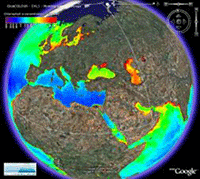
|

GlobColour Products Description
Format
GlobColour
Level-3 output data includes binned, mapped and browse products. The binned
and mapped products are stored in netCDF files. The netCDF library or
third-party tools including netCDF readers must be used to read the GlobColour
products. The browse products are written in PNG format.
netCDF
(Network Common Data Form) is a machine-independent, self-describing,
binary data format standard for exchanging scientific data.
Full
details about the products format and content are available in the Product
User Guide.
The
following rules are applied when writing the global binned (ISIN grid)
and mapped products (PC grid):
- each
parameter is stored in a single file including metadata and accumulated
statistical data
- global
metadata are stored as global attributes
- accumulated
statistical data are stored as variables
- metadata
related to statistical data are stored as variable attributes.
The
following rules are applied when writing the DDS binned and mapped products
(PC grid):
- all
parameters are stored in a single file including metadata and accumulated
statistical data
- global
metadata are stored as global attributes
- accumulated
statistical data are stored as variables
- metadata
related to statistical data are stored as variable attributes.
The
file naming convention of the GlobColour products (common to all products)
follows the following rules :
Lzz_date_time_ROI_SR_INS_PRD_TC_nn.ext
where:
- Lzz
is the product level (L3b for level 3 binned ISIN grid, L3m for level
3 mapped grid)
- date
is specified in UTC format as yyyymmdd[-yyyymmdd]. The end date is
optional for track and daily products.
- time
is specified in UTC format as hhmmss[-duration]. The time field is
needed only for track products. The duration is expressed in seconds.
- ROI
is the name of the region of interest (e.g. GLOB for global coverage,
site name for DDS).
- SR indicates
the resolution of the grid (e.g. 4 for 1/24 ISIN grid).
- INS
is the instrument acronym (MER for MERIS, MOD for MODIS, SWF for SeaWiFS
or any combinations of these names for the merged products). For the
merged products, the instrument acronym is prefixed with the merging
method (AV for simple average, AVW for weighted average, GSM for the
GSM model).
- PRD
is the product type (CHL for chlorophyll...). Note that the various
merging algorithms can be indicated in this field using a - delimiter
(e.g. CHL1-M01, CHL1-M02).
- TC is
the time coverage (TR for track-level products, DAY for daily, 8D
for 8days, MO for monthly, YR for annual products).
- nn is
a counter. For track products, we store in this counter the data-day
in yyyymmdd format.
- ext
is the file extension (nc for netCDF files, png for PNG files)
The
number of field is constant. Missing information leads to two adjacent
underscores.
Examples:
- L3b_20040101_072312-2363_GLOB_4_MER_L555_TR_20040101.nc
- L3m_20040401__ZON1_025_MOD_CHL1_DAY_00.nc
- L3b_20040401-20040430__GLOB_4_MER_L413_MO_00.nc
- L3b_20021001-20021031__GLOB_4_AV-MERMODSWF_T865_MO_00.nc
- L3b_20040101-20041231__NMED_9_MIX_YS_YR_00.nc
|
IMPORTANT
NOTICE
All images and data available on this GlobColour website are
for research and educational use only
|

The European Service for Ocean Colour - GlobColour is an ESA Data User
Element Project
|

